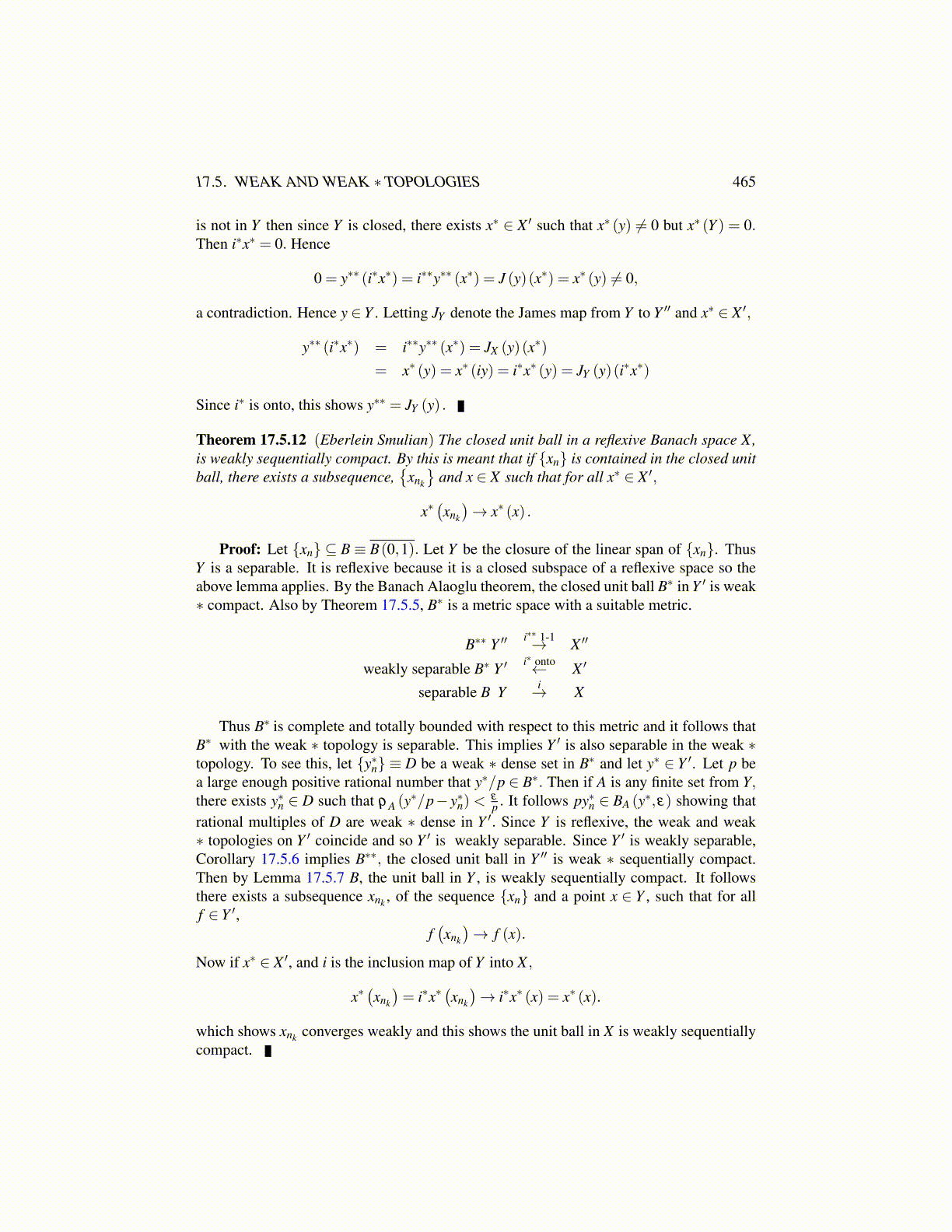
17.5. WEAK AND WEAK ∗ TOPOLOGIES 465
is not in Y then since Y is closed, there exists x∗ ∈ X ′ such that x∗ (y) ̸= 0 but x∗ (Y ) = 0.Then i∗x∗ = 0. Hence
0 = y∗∗ (i∗x∗) = i∗∗y∗∗ (x∗) = J (y)(x∗) = x∗ (y) ̸= 0,
a contradiction. Hence y ∈ Y . Letting JY denote the James map from Y to Y ′′ and x∗ ∈ X ′,
y∗∗ (i∗x∗) = i∗∗y∗∗ (x∗) = JX (y)(x∗)
= x∗ (y) = x∗ (iy) = i∗x∗ (y) = JY (y)(i∗x∗)
Since i∗ is onto, this shows y∗∗ = JY (y) .
Theorem 17.5.12 (Eberlein Smulian) The closed unit ball in a reflexive Banach space X,is weakly sequentially compact. By this is meant that if {xn} is contained in the closed unitball, there exists a subsequence,
{xnk
}and x ∈ X such that for all x∗ ∈ X ′,
x∗(xnk
)→ x∗ (x) .
Proof: Let {xn} ⊆ B ≡ B(0,1). Let Y be the closure of the linear span of {xn}. ThusY is a separable. It is reflexive because it is a closed subspace of a reflexive space so theabove lemma applies. By the Banach Alaoglu theorem, the closed unit ball B∗ in Y ′ is weak∗ compact. Also by Theorem 17.5.5, B∗ is a metric space with a suitable metric.
B∗∗ Y ′′ i∗∗ 1-1→ X ′′
weakly separable B∗ Y ′ i∗ onto← X ′
separable B Y i→ X
Thus B∗ is complete and totally bounded with respect to this metric and it follows thatB∗ with the weak ∗ topology is separable. This implies Y ′ is also separable in the weak ∗topology. To see this, let {y∗n} ≡ D be a weak ∗ dense set in B∗ and let y∗ ∈ Y ′. Let p bea large enough positive rational number that y∗/p ∈ B∗. Then if A is any finite set from Y,there exists y∗n ∈ D such that ρA (y
∗/p− y∗n) <ε
p . It follows py∗n ∈ BA (y∗,ε) showing thatrational multiples of D are weak ∗ dense in Y ′. Since Y is reflexive, the weak and weak∗ topologies on Y ′ coincide and so Y ′ is weakly separable. Since Y ′ is weakly separable,Corollary 17.5.6 implies B∗∗, the closed unit ball in Y ′′ is weak ∗ sequentially compact.Then by Lemma 17.5.7 B, the unit ball in Y , is weakly sequentially compact. It followsthere exists a subsequence xnk , of the sequence {xn} and a point x ∈ Y , such that for allf ∈ Y ′,
f(xnk
)→ f (x).
Now if x∗ ∈ X ′, and i is the inclusion map of Y into X ,
x∗(xnk
)= i∗x∗
(xnk
)→ i∗x∗ (x) = x∗ (x).
which shows xnk converges weakly and this shows the unit ball in X is weakly sequentiallycompact.